17.6 Diseases and Disorders of the Endocrine System
Acromegaly
Acromegaly (ak-rō-MEG-ă-lē) is an endocrine disorder in adults caused when abnormally high levels of human growth hormone (HGH) trigger additional growth of the bones in the face, hands, and feet. Because the growth plates are closed in adults, the bones grow wider and thicker. In most cases, acromegaly is caused by a benign tumor in the pituitary gland, called a pituitary adenoma (ăd-ĕ-NŌ-mă). Treatment may include surgery, medications, and/or radiation therapy to remove or control tumor size and return HGH levels back to normal.[1] See Figure 17.2[2] for an image of a man with acromegaly with enlarged bones in the face and hands.

Addison’s Disease
Addison’s disease (ăd-ĭ-Sŏnz dĭ-ZĒZ) is a disorder in which the adrenal glands don’t produce enough cortisol and aldosterone hormones, also called adrenal insufficiency (ă-drē-năl ĭn-sŭ-fĭsh-ĕn-sē). Decreased cortisol results in hypoglycemia (hī-pō-glī-SĒ-mē-ă), which is low blood glucose levels. Because aldosterone helps maintain the balance of sodium and potassium in the blood and regulates blood pressure, low aldosterone levels cause hypotension (hī-pō-TĔN-shŭn), which is low blood pressure. Other symptoms of Addison’s disease are fatigue, muscle weakness, loss of appetite, weight loss, and abdominal pain. The most serious complication of adrenal insufficiency is called adrenal crisis. If not treated right away, adrenal crisis can cause death.[3],[4]
Adrenal insufficiency is commonly diagnosed by an ACTH stimulation test. In this diagnostic test, ACTH is administered intravenously (IV), and then blood samples are taken to measure cortisol levels in the blood. The normal response is a rise in blood cortisol levels, but people with Addison’s disease have little or no increase in cortisol levels. Treatment of Addison’s disease consists of hormone replacement medication to restore normal levels of cortisol and aldosterone.[5],[6]
Cushing’s Disease and Cushing’s Syndrome
Cushing’s disease (KŪSH-ĭngz dĭ-ZĒZ) is a disorder caused by the excessive secretion of cortisol, resulting in hyperglycemia (hī-pĕr-glī-SĒ-mē-ă), which is elevated blood glucose levels. A common cause of Cushing’s disease is a pituitary tumor. Cushing’s syndrome (KŪSH-ĭngz SĬN-drōm) happens when the body makes too much cortisol, or the person is taking medications called glucocorticoids that affect the body the same way as cortisol. A syndrome (SĬN-drōm) refers to signs and symptoms that occur together that are characteristic of a specific disorder.
Too much cortisol causes symptoms such as a fatty hump between the shoulders, thin legs and arms, a round face, easy bruising, and pink or purple stretch marks on the skin called striae (STRĪ-ē). See Figure 17.3[7] for an illustration of a person with Cushing’s syndrome. It can also cause high blood pressure, bone loss, poor wound healing, and type 2 diabetes. Treatment depends on the cause. If glucocorticoid medications are being taken, their use is reduced or eliminated, if possible. If a tumor is the cause, then it is removed by surgery or reduced in size by radiation therapy. Medications may also be prescribed to control the body’s production of cortisol.[8]
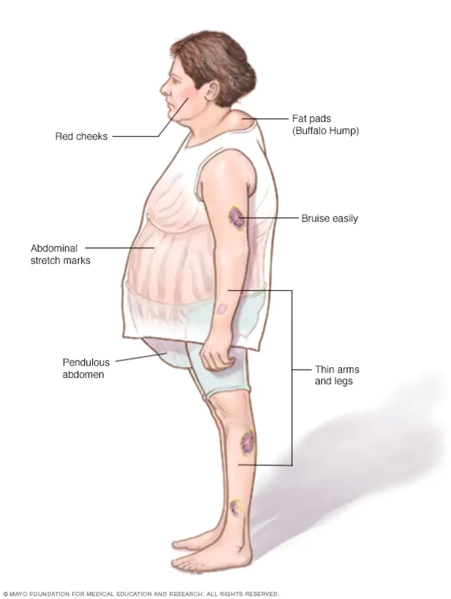
Diabetes Insipidus
Diabetes insipidus (dī-ă-BĒ-tēz in-SIP-ĭ-dŭs) (DI) is condition caused by a lack of antidiuretic hormone (ADH). It is characterized by large amounts of very dilute urine, referred to as polyuria (pŏl-ē-YŌŌR-ē-ă). While most people make 1 to 3 quarts of urine a day, people with diabetes insipidus can make up to 20 quarts of urine a day. See Figure 17.4[9] for an image of dilute urine seen in polyuria. DI is often treated with medication that mimics the effects of ADH. Note that diabetes insipidus is not the same as diabetes mellitus. Although both conditions can increase thirst and polyuria, they are not related.[10]
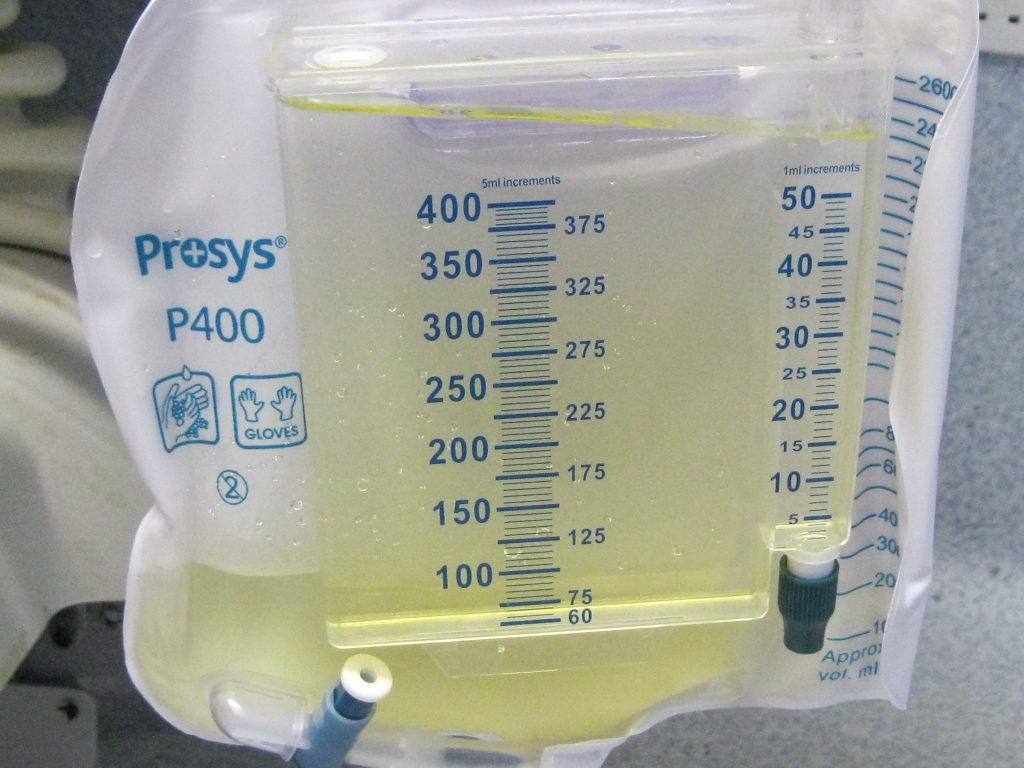
Diabetes Mellitus
Diabetes mellitus (dī-ă-BĒ-tēz MĔL-ĭ-tŭs) (DM) refers to disorders that cause hyperglycemia (high levels of glucose in the blood). Over time, hyperglycemia damages the blood vessels in the heart, kidneys, feet, and eyes.
There are different types of diabetes called type 1, type 2, and gestational. Type 1 diabetes (tīp wŭn dī-ă-BĒ-tēz) is caused by an autoimmune disease that destroys the cells of the pancreas that create insulin. In type 2 diabetes (tīp tōō dī-ă-BĒ-tēz), the cells of the body do not use insulin effectively to facilitate the uptake of glucose for energy. Additionally, the pancreas may not be making enough insulin to maintain blood glucose levels within normal range. Gestational diabetes (jĕs-TĀ-shŭn-ăl dī-ă-BĒ-tēz) refers to a type of diabetes that develops during pregnancy. Gestational diabetes typically goes away after the baby is born, but it increases the risk of the mother for developing type 2 diabetes later in life.
Common symptoms of untreated diabetes are:
- Polydipsia (pŏl-ē-DĬP-sē-ă): Excessive thirst
- Polyuria (pŏl-ē-YŌŌR-ē-ă): Excessive urine output
- Polyphagia (pŏl-ē-FĀ-jē-ă): Excessive hunger/eating
Diabetes mellitus is diagnosed with blood tests that evaluate blood glucose levels, including the following tests:
- Fasting blood glucose (FĂST-ing blŭd GLŪ-kōs) (FBG): Assesses an individual’s blood glucose level when they have had no caloric intake for at least eight hours. The normal fasting blood glucose range is between 70-100 mg/dL. Hypoglycemia (hī-pō-glī-SĒ-mē-ă) refers to an abnormally low blood glucose level below 70 mg/dL.
- Random blood glucose (răn-dŏm blŭd GLŪ-kōs): Measures the level of glucose in the blood at any given time, without the requirement for fasting.
- Hemoglobin A1C (HĒ-mō-glō-bĭn Ā-wŭn-SĒ) (HbA1C): Assesses an individual’s average blood glucose levels over the preceding two to three months. HbA1C is a form of hemoglobin. When glucose is in the bloodstream, it attaches to hemoglobin, forming glycated hemoglobin. The normal range for HbA1C is typically less than 5.7%.
- Oral glucose tolerance test (ŌR-ăl GLŪ-kōs TŌL-ĕr-ăns tĕst) (OGTT): Evaluates the body’s ability to regulate blood glucose levels, especially after consuming a high dose of glucose. The results are typically reported as blood glucose levels measured at different time points (such as fasting one hour post-glucose consumption and two hours post-glucose consumption). Elevated blood glucose levels at any of these time points indicate diabetes. This test is often performed during pregnancy to assess for gestational diabetes.
People with diabetes must monitor their blood glucose levels and often adjust their medications based on these levels. See Figure 17.4[11] for an image of a blood glucose monitor typically used in hospital and home settings.[12]
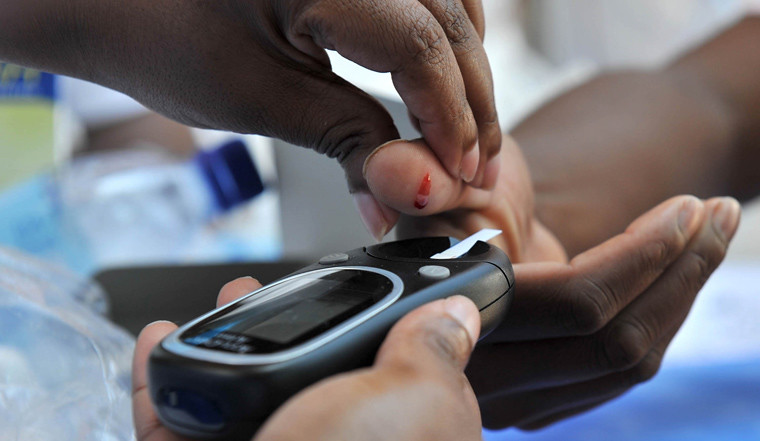
Diabetes is treated with insulin injections, oral medications, or inhaler medications. Some people with type 1 diabetes have insulin pumps they wear outside of their body that deliver steady doses of insulin to mimic the function of the pancreas.[13]
A potentially life-threatening complication of type 1 diabetes is diabetic ketoacidosis (dī-ă-BĔT-ĭk kē-tō-ăs-ĭ-DŌ-sĭs) (DKA). DKA develops when the body breaks down fatty acids for energy when there isn’t enough insulin to facilitate the update of glucose into cells. As a result, excessive ketones are created, causing the body to become acidic. Treatment includes intravenous administration of insulin, fluids, and electrolytes to restore normal body functioning.
Gigantism
Gigantism (jī-GĂN-tĭz-əm) is a rare endocrine condition characterized by excessive growth and height significantly above average. This condition is caused by the overproduction of human growth hormone (HGH) in childhood, often due to an HGH-secreting pituitary tumor. Treatment for gigantism is based on the cause and may include surgery or radiation to remove or shrink the tumor.[14] See Figure 17.5[15] for an image of an individual with gigantism compared to an individual of average height.

Hirsutism
Hirsutism (HĬR-sū-tĭz-əm) refers to the overgrowth of hair in women, such as on the chin and face, due excessive production of androgens. See Figure 17.6[16] for an image of hirsutism. Hirsutism is caused by endocrine disorders such as polycystic ovary syndrome (PCOS) and Cushing’s syndrome or from side effects of certain medications. Treatment may include medications or hair removal options.[17]
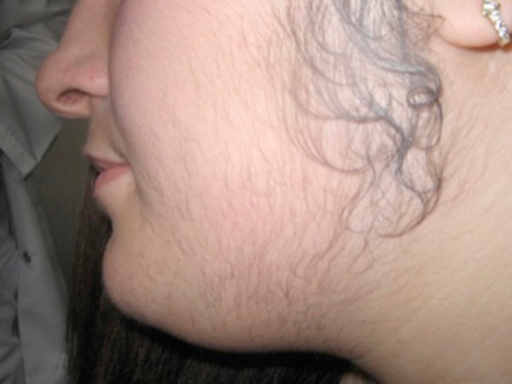
Hyperparathyroidism
Hyperparathyroidism (hī-pĕr-PĂR-ă-THĪ-rŏid-ĭzm) refers to a condition in which the parathyroid glands produce too much parathyroid hormone (PTH), leading to hypercalcemia (hī-pĕr-kăl-SĒ-mē-ă), which is excessive calcium in the blood. Treatment is based on the cause. For example, if the condition is caused by a tumor on one or more of the parathyroid gland(s), a parathyroidectomy (păr-ă-thī-royd-ĔK-tō-mē) is performed to remove the affected parathyroid gland.[18]
Hyperthyroidism
Hyperthyroidism (hī-pĕr-THĪ-rŏid-ĭzm) refers to abnormally high levels of thyroid hormones (i.e., T3 and T4) that cause increased metabolism and symptoms like unintended weight loss, profuse sweating, and increased heart rate. Conditions that can cause hyperthyroidism are as follows:
- Grave’s disease (GRĀVZ dĭ-ZĒZ): An autoimmune disorder of the thyroid gland causing the production of excess thyroid hormones
- Adenomas (ăd-ĕ-NŌ-măz): Overactive thyroid nodules that produce thyroid hormones
- Thyroiditis (thī-royd-ĪT-ĭs): Inflammation of the thyroid gland
A classic symptom of Grave’s disease is exophthalmos (ek-saaf-thal-muhs), which refers to bulging eyes. See Figure 17.7[19] for an image of exophthalmos.
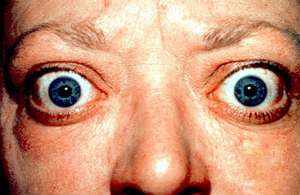
Several treatments are available for hyperthyroidism, such as antithyroid medications, radioactive iodine therapy, or surgery to remove all or part of the thyroid gland, referred to as a thyroidectomy (thī-royd-EK-tŏ-mē).[20]
Hypoparathyroidism
Hypoparathyroidism (hī-pō-păr-ă-THĪ-rŏid-ĭzm) is a condition in which the parathyroid glands do not produce enough parathyroid hormone (PTH), leading to hypocalcemia (hī-pō-kăl-SĒ-mē-ă), low levels of calcium in the blood. Hypoparathyroidism can be caused by accidental damage to the parathyroid glands during thyroid or neck surgery or due to an autoimmune disease. It is treated with parathyroid hormone replacement and supplements like calcium and vitamin D.[21]
Hypothyroidism
Hypothyroidism (hī-pō-THĪ-rŏid-ĭzm) refers to abnormally low levels of thyroid hormones (T3 and T4) produced by the thyroid gland. Symptoms include unintended weight gain, fatigue, constipation, cold sensitivity, and memory problems. A goiter (GOI-tĕr) is a symptom of hypothyroidism and hyperthyroidism and is an abnormal enlargement of the thyroid gland. See Figure 17.8[22] for an image of a goiter. Hypothyroidism is treated with lifelong thyroid hormone replacement medication and routine blood tests to maintain normal blood levels of thyroid hormones.[23]
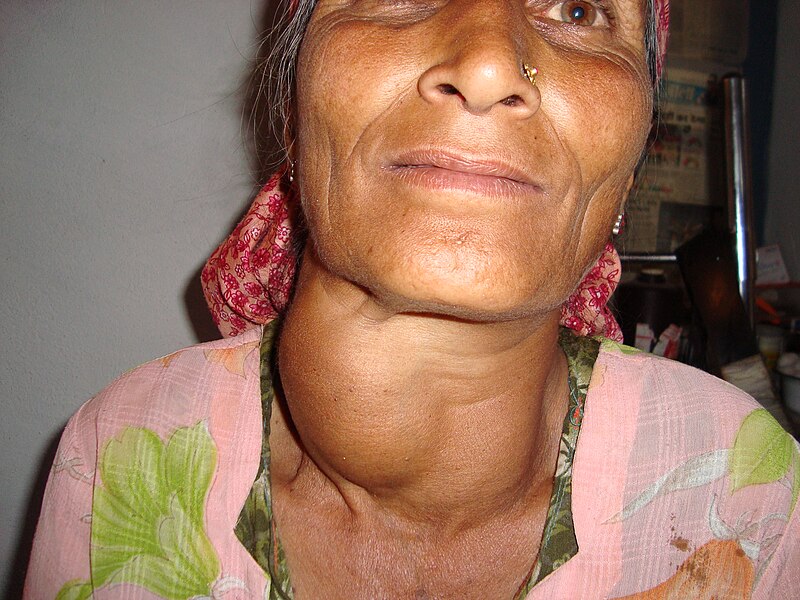
Polycystic Ovary Syndrome
Polycystic ovary syndrome (pŏl-ē-SĬS-tĭk Ō-văr-ē SĬN-drōm) (PCOS) is a common hormone problem for women of childbearing age. Women with PCOS have multiple small cysts on the ovaries and may not ovulate. See Figure 17.9[24] for an illustration of PCOS. They may have high levels of androgens. PCOS can cause missed or irregular menstrual periods, hirsutism (excessive hair growth), acne, infertility, and unintended weight gain.[25]
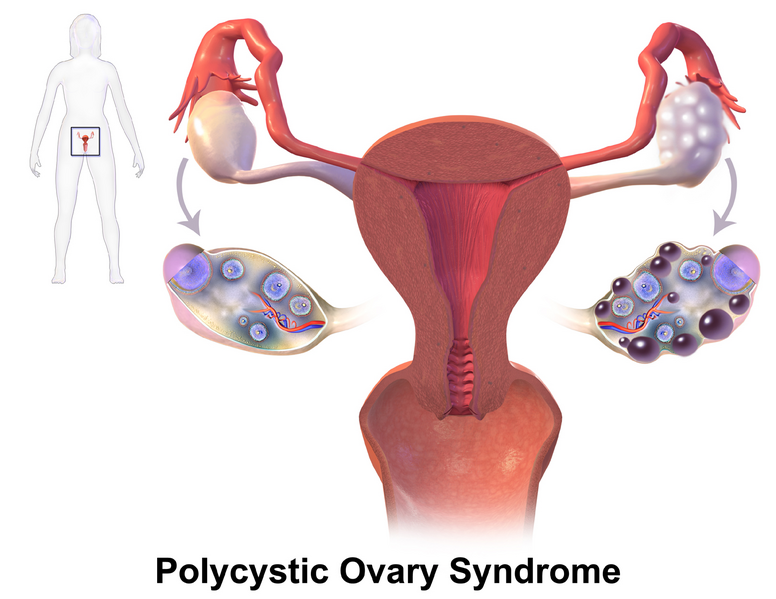
- National Institute of Diabetes and Digestive and Kidney Disorders. (2020, January). Acromegaly. National Institutes of Health. https://www.niddk.nih.gov/health-information/endocrine-diseases/acromegaly ↵
- “Man_showing_the_characteristic_appearances_of_acromegaly_Wellcome_L0062529.jpg” by unknown author via Welcome Collection Gallery and is licensed under CC BY 4.0 ↵
- National Institute of Diabetes and Digestive and Kidney Diseases. (n.d.). Adrenal insufficiency & Addison's disease. National Institutes of Health. https://www.niddk.nih.gov/health-information/endocrine-diseases/adrenal-insufficiency-addisons-disease ↵
- Mayo Clinic. (2022, December 8). Addison's disease. https://www.mayoclinic.org/diseases-conditions/addisons-disease/symptoms-causes/syc-20350293 ↵
- National Institute of Diabetes and Digestive and Kidney Diseases. (n.d.). Adrenal insufficiency & Addison's disease. National Institutes of Health. https://www.niddk.nih.gov/health-information/endocrine-diseases/adrenal-insufficiency-addisons-disease ↵
- Mayo Clinic. (2022, December 8). Addison's disease. https://www.mayoclinic.org/diseases-conditions/addisons-disease/symptoms-causes/syc-20350293 ↵
- “Cushing%27s_Syndrome.webp” by Mayo Clinic is licensed under CC BY-SA 4.0 ↵
- Mayo Clinic. (2023, June 7). Cushing's syndrome. https://www.mayoclinic.org/diseases-conditions/cushing-syndrome/symptoms-causes/syc-20351310 ↵
- “31388976010_b0750ceed4_k.jpg” by John Campbell is licensed in the Public Domain. ↵
- National Institute of Diabetes and Digestive and Kidney Disease. (2021, September). Diabetes insipidus. National Institutes of Health. https://www.niddk.nih.gov/health-information/kidney-disease/diabetes-insipidus ↵
- “8286152103_b624d39f68_c.jpg” by GovernmentZA is licensed under CC BY-ND 2.0 ↵
- National Institute of Diabetes and Digestive and Kidney Diseases. (n.d.). Diabetes. National Institutes of Health. https://www.niddk.nih.gov/health-information/diabetes ↵
- National Institute of Diabetes and Digestive and Kidney Diseases. (n.d.). Diabetes. National Institutes of Health. https://www.niddk.nih.gov/health-information/diabetes ↵
- Cleveland Clinic. (2022, May 9). Gigantism. National Institutes of Health. https://my.clevelandclinic.org/health/diseases/22954-gigantism ↵
- “Robert_Wadlow_postcard.jpg” by unknown author is licensed in the Public Domain. ↵
- “PMC4103002_ircmj-16-9410-g001.png” by Gacaferri Lumezi B. et al., is licensed under CC BY 3.0 ↵
- Cleveland Clinic. (2022, July 8). Hirsutism. https://my.clevelandclinic.org/health/diseases/14523-hirsutism ↵
- Mayo Clinic. (2022, May 17). Hyperparathyroidism. https://www.mayoclinic.org/diseases-conditions/hyperparathyroidism/diagnosis-treatment/drc-20356199 ↵
- “Proptosis_and_lid_retraction_from_Graves%27_Disease.jpg” by Jonathan Trobe, M.D. - University of Michigan Kellogg Eye Center is licensed under CC BY 3.0 ↵
- Mayo Clinic. (2022, November 30). Hyperthyroidism. https://www.mayoclinic.org/diseases-conditions/hyperthyroidism/symptoms-causes/syc-20373659 ↵
- Mayo Clinic. (2022, May 11). Hypoparathyroidism. https://www.mayoclinic.org/diseases-conditions/hypoparathyroidism/symptoms-causes/syc-20355375 ↵
- “Goiter.JPG” by Dr. J.S.Bhandari, India is licensed under CC BY-SA 3.0 ↵
- Mayo Clinic. (2022, December 10). Hypothyroidism. https://www.mayoclinic.org/diseases-conditions/hypothyroidism/symptoms-causes/syc-20350284 ↵
- “PCOS_%28Part_2%29.png” by BruceBlaus is licensed under CC BY-SA 4.0 ↵
- Johns Hopkins Medicine. (n.d.). Polycystic ovary syndrome (PCOS). https://www.hopkinsmedicine.org/health/conditions-and-diseases/polycystic-ovary-syndrome-pcos ↵

